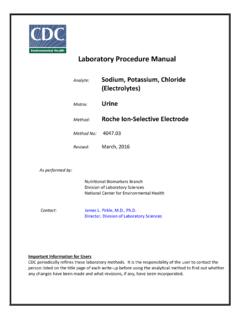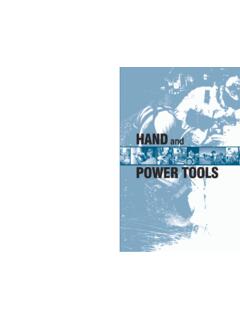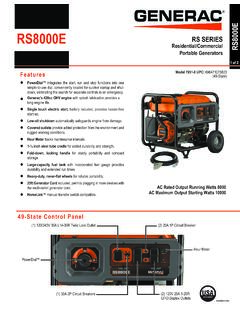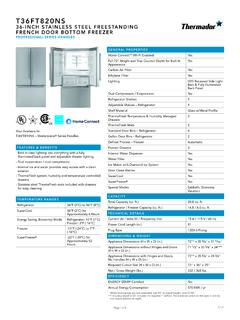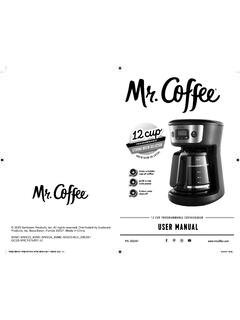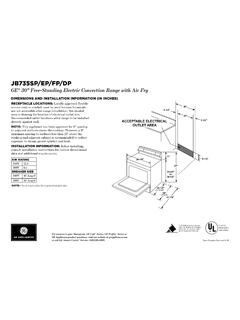Transcription of Body Measurements (Anthropometry) Manual
1 NATIONAL HEALTH AND NUTRITION EXAMINATION SURVEY IIIBody Measurements ( anthropometry )Westat, Research BoulevardRockville, MD 20850(301) 251-1500 October 1988 TABLE OF TO of of of Exam Room in of Equipment and of Stand and Setup the Printer for Weight Large Sliding Sliding Breadth Measuring Weight Measuring and of of Stand OF CONTENTS (continued) measurement of Anthropometric Examiner and and Recording Leg Arm (Waist) (Hip) of measurement Components, SP Position,and Examiner Equipment for Adults 20+.. Children under Eight Years of Handicapped SP OF CONTENTS (continued) Data AND Appointment Calibration of Forms and Exam Data of Data Data , Observations and Movement and OF CONTENTS (continued)List of ExhibitsExhibitPage3-1SP Position for Standing Position for Sitting Position for Upper Leg Length Location and Upper Leg Position for Knee Position for Arm Length Position and Location of Upper Arm Tape Position for Abdominal (waist) Tape Position for Buttocks of Triceps of Subscapular of Suprailiac Position for Elbow of the measurement All measurement Daily Log Calibration INTRODUCTION TO of AnthropometryNutrition is a major determinant of health, and the resolution of many nutritional issues ofpublic health concern requires survey data.
2 One of the major aims of NHANES III is to provideinformation useful for studying the relationship among diet, nutritional status, and health. In addition todietary intake methodologies, questionnaire material, hematological tests, and nutritional biochemistries,the assessment of nutritional status requires a series of stature, weight, and other is the study of the measurement of the human body in terms of the dimensionsof bone, muscle, and adipose (fat) tissue. Measures of subcutaneous adipose tissue are important becauseindividuals with large values are reported to be at increased risks for hypertension, adult-onset diabetesmellitus, cardiovascular disease, gallstones, arthritis, and other disease, and forms of cancer. Combinedwith the dietary and related questionnaire data, and the biochemical determinations, anthropometry isessential and critical information needed to assist in describing the data collected from persons in theNHANES III of AnthropometricsActual stature, weight, and body Measurements including skinfolds, girths, and breadths willbe collected in the MEC for purposes of assessing growth, body fat distribution, and for provision ofreference data.
3 Measurements of stature and weight will allow for a revision of the child growth chartswhich are based in part on data collected in NHES cycles II and III and data from the Fels LongitudinalStudy. Anthropometric Measurements such as skinfolds and circumferences and bioelectrical impedance(a method used to estimate the amount of lean tissue) will allow cross-sectional analysis of the relationshipbetween obesity and risk of disease. Therefore, many of the Measurements included in NHANES III willrepeat ones made in previous NHANES and HHANES so that trend analyses can be conducted. Somemeasures have been added to provide further information on body frame size and fat distribution, whileothers have been dropped because new data have determined that other measures are more of Exam Room in MECThe body measurement room is located in trailer #4 of the MEC.
4 The room is equipped withsome unique features designed to facilitate an accurate and efficient measurement procedure. Thesefeatures include strategically placed mirrors and a custom-built table for SP s to sit on. The Toledo scale,stadiometer, and infant measurement board are all contained in this room. The body measurement roomis shared with the allergy component and the MEC of Equipment and SuppliesThe equipment and supplies necessary for body Measurements are as follows: body measurement tableToledo self-zeroing weight scaleStadiometerInfant measuring boardMeasurement box for sitting heightInsertion tapeSteel measuring tapeHoltain skinfold caliperHoltain small sliding breadth caliper2 Mediform large sliding calipersPolaroid Land camera with close-up photographic lensSpecial light attachment for cameraPolaroid filmCalculatorComputer terminalWeights for scale calibrationCalibrations rodsStep wedge standardsCosmetic pencils (wax base)FootstoolScissors - blunt edgePaper tapeWhite vinegarAlcoholBaby oilGauze 4x42-1 Inventory of Equipment and SuppliesAt the beginning of each stand and at the end of each stand, the health technician should takean inventory of the equipment and supplies needed for the body measurement examination component asdiscussed in Standardized Procedures.
5 Any pieces of equipment that are missing should be reported tothe MEC of Stand ProceduresUnpack the calipers and supplies and arrange accordingly in the room. Clean and calibrate theequipment as discussed in this and Setup in the power the weight blocks and move to the front of the the scale platform by removing the table paper between the platform and the Printer for Weight ScaleThe printer comprises a bank of numbers and letters that indicate, from left to right, time (AMor PM), date and weight. To set the time/date function displayed in the LED on the front panel, do the power cord into the power the two push buttons on the panel of the printer above the attached power top one is the "set" button; the bottom one is the "advance" the "set" button to cause the right most LED digit to begin blinking. Press the"advance" button to advance the numerals until the correct year designation "set" once again to fix that numeral in the LED and cause the second digit from theright to begin the above process through the six-digit field that represents the date and the four-digit field that represents the time.
6 Although the time must be set according to a 24-hourclock, time will appear on the AM and all the digits have been correctly set, press the "set" button twice to start the the light into the power the light from the camera-holding the horizontal Large Sliding caliper is calibrated at the beginning of the stand and once every two weeks duringthe the small and medium calibration caliper reading should agree with the known values of the calibration the caliper readings on the Equipment Calibration Log under the the two readings do not agree, inform the MEC manager and use the spare set Sliding Breadth the small sliding breadth calipers at the beginning of the stand andonce everytwo weeks during the stand using the step wedge caliper reading should agree with the known values of the step wedge the caliper readings on the Equipment Calibration any abnormality is noticed, use the spare set of small sliding breadth calipers and notifythe MEC Measuring infant measuring board is checked at the beginning of each stand and once every twoweeks by placing the calibration rod(s) on the board to check that the board has not beendamaged during transit.
7 Check the digital counter reading against the known values ofthe calibration rod(s) to make sure they the counter reading on the Equipment Calibration Log under the appropriateheading. If the two readings do not agree, inform the MEC the height scale at the beginning of each stand, once every two weeks, and atthe end of each stand after all the calibration rods separately on the floor of the the horizontal bar of the stadiometer firmly against the top of each calibration a Polaroid photograph of the stadiometer tape. The measurement should be equalto the known value of each calibration rod. If it is not, adjust the sighting window on theheight scale until the measurement does agree and rephotograph the stadiometer Weight the weight scale at the beginning of each stand and at the end of each the electronic digital system in the pound mode by pressing the LB/KG button thekeyboard until the readout is in tenths.
8 If the digital readout does not register " ,"press the zero key to automatically balance the scale at zeroing the scale properly, print the zero weight on a sheet of 8 1/2 x 11 calibration weights on the scale in increments of 25 pounds, starting with 25 andcontinuing to the weight in pounds at each increment on the calibration paper by pressing thePRINT key on the time/date unit. At 100 pounds, print the weight in pounds and inkilograms to attest to the accuracy of the pound/kilogram the scale is out of calibration by at least one-half pound at more than three levels,inform the MEC a satisfactory calibration is obtained, record the stand number, stand location, date,and tech number on the paper and save it with the Equipment Calibration the Holtain skinfold calipers at the beginning and end of each stand andoncea weekduring each stand using the step wedge the calipers before starting the calibration procedures.
9 Place the step wedge standardbetween the caliper arms at each of the five steps, and check that the reading on the scalecorresponds to the standard the measurement taken at each step on the Equipment Calibration Log under theappropriate heading. An identical calibration should be done on the spare set of skinfoldcalipers and the corresponding Measurements also recorded on the calibration log careful to record the caliper s values on the correct device identification line. (Thespare is not always the B instrument.) the calipers are 1 mm or more out of calibration at any level, use the other set ofcalipers and inform the MEC manager. They will be returned to the manufacturer the calipers become too loose, use the spare set of calipers and inform the CalipersBefore each examining session, the calipers should be "zeroed.
10 " Check to make sure thepointer is clearly reading zero. If not, loosen the flat screw on top of the dial, turn the dial slowly andgently until the pointer reads zero and then turn the screw tight technician assigned to the body measurement station should apply a random set ofthe standard weights daily to roughly check the accuracy of the weight scales. This checkis noted in the Equipment Calibration there is any reason to believe that the scales are not accurate, do a completerecalibration. The recording of the calibration should be recorded in the EquipmentCalibration Log and the MEC manager should be Measuring day check that the digital counter and the foot board are operating smoothly. If theyare not, a small amount of lubrication can be applied. IF the operation is still not smooth,inform the MEC day check that the upright bar and attached tape measure have not been check is noted in the Equipment Calibration that the horizontal bar is firmly attached to the upright sliding section and that thesection operates smoothly.







